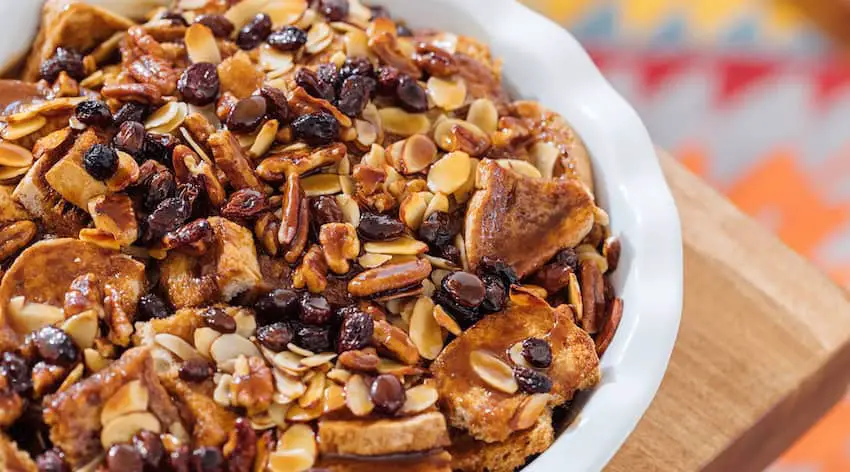A Mexican capirotada for this holiday season

Bread pudding has been around for a very long time, dating back to around the 11th century, when it first emerged in England. It didn’t take long for the dish to spread to other regions, with savory versions becoming popular in Spain. In fact, that’s where the capirotada hales, though it took about four centuries for a recipe to evolve. In fact, it was influenced by earlier Roman fare like sala cattabia, which soaked stale bread with various ingredients. The Spanish, however, embellished the concept, changed it, and brought the dish with them when they colonized Mexico, in the early 16th century.
The Mexicans took the Spanish capirotada and infused it with local ingredients and flavors to make it their own. They used bolillo (a type of bread) and piloncillo (unrefined sugar) as well as raisins, cinnamon, cloves, and even cheese. Depending upon regional adaptations, they even incorporated dried or tropical fruits and nuts (our recipe, for example, includes bananas). But the main difference is the moisture.

Unlike European bread puddings, traditional Mexican capirotada gain moisture and flavor because of the syrup they are baked in (a combo of piloncillo dissolved in water or milk with added spices). It therefore has more of a “layered texture” than its custard counterpart and is less mushy. Whereas European bread puddings will virtually all taste the same, Mexican capirotada will taste very different depending upon the area of Mexico in which it is created and the ingredients which are added.
But let’s not forget its cultural impact. Capirotada is most traditionally associated with Lent and Easter, with each ingredient having deep religious symbolism. The bread represents the body of Christ; piloncillo syrup represents His blood; cinnamon sticks represent the wood of the cross; while whole cloves symbolize the nails used to pierce His hands and feet.
This bread pudding is not only a culinary delight, but also expresses the faith and tradition of the Mexican people and their culture. I think it would make a wonderful dessert for any festive occasion, and with the holidays coming up, what better time is there to dig in?
Capirotada:


Ingredients:
- Oil or butter, for greasing baking dish
- 4 large bolillo bread rolls, cut into 1-inch-thick pieces (about 10-12 cups)
- 5 Cups (1230 g) nonfat milk (leche descremada)
- 1 (8-ounce) (about 225 g) cone piloncillo oscuro (or 1 1/4 Cups [312 g] dark-brown sugar, [azúcar moreno oscuro])
- Piloncillo is made when sugar cane juice is boiled into a thick syrup and poured into cone-shaped molds to harden and is in fact, named after its conical shape. Like brown sugar, there are two types: blanco (light) and oscuro (dark). We will use oscuro for this recipe. Available in Mexican markets and supermarkets.
- 3 cinnamon sticks (canela en rama)
- 2 whole cloves (clavo entero)
- 3 large bananas (plátano), sliced into rounds
- 1 cup (200 g) raisins (pasas)
- 1/2 cup (55 g) sliced almonds (almendras en rodajas) (Some recipes use peanuts [cacahuetes], your choice.)
- 2 cups (224 g) shredded Oaxaca cheese (or any white cheese like Monterey Jack, Provolone, or Mozzarella)
Instructions:
- Preheat the oven to 350°F/175C.
- Grease a 9×13 inch baking dish with oil or butter. Set aside.
- Place the cubed bolillo bread onto a large baking sheet.
- Bake for 5 minutes so that bread becomes slightly toasted and dried.
- Remove from oven and set aside.
- Put the milk, piloncillo, cinnamon sticks, and cloves into a large pot, and over medium-high heat, whisk, and bring to a gentle boil.
- Reduce the heat to low and simmer for 10 minutes, uncovered, whisking occasionally.
- Remove from heat and discard cinnamon sticks and cloves.
Assemble the capirotada:
- Spread half of the toasted bread in a single layer in the prepared baking dish.
- Top with all the banana slices, half the raisins, half the sliced almonds (or peanuts) and half the shredded cheese.
- Repeat the process with the remaining ingredients to make one more layer.
- Carefully pour the sweetened milk over the capirotada, paying close attention to soak the bread on the edges.
- Cover the dish with aluminum foil and bake for 15 minutes, then remove the foil and bake for 15 minutes longer.
- Remove from the oven, let cool for 5 minutes, and serve warm. Or let it cool completely, cover and refrigerate, and serve cold.
Disfruta!
Deborah McCoy is the one-time author of mainstream, bridal-reference books who has turned her attention to food, particularly sweets, desserts and fruits. She is the founder of CakeChatter™ on FaceBook and X (Twitter), and the author of four baking books for “Dough Punchers” via CakeChatter (available @amazon.com). She is also the president of The American Academy of Wedding Professionals™ (aa-wp.com).
Source: Mexico News Daily

